The AMD Radeon R9 Nano Review: The Power of Size
by Ryan Smith on September 10, 2015 8:00 AM ESTCompute
Shifting gears, we have our look at compute performance.
Starting us off for our look at compute is LuxMark3.0, the latest version of the official benchmark of LuxRender 2.0. LuxRender’s GPU-accelerated rendering mode is an OpenCL based ray tracer that forms a part of the larger LuxRender suite. Ray tracing has become a stronghold for GPUs in recent years as ray tracing maps well to GPU pipelines, allowing artists to render scenes much more quickly than with CPUs alone.
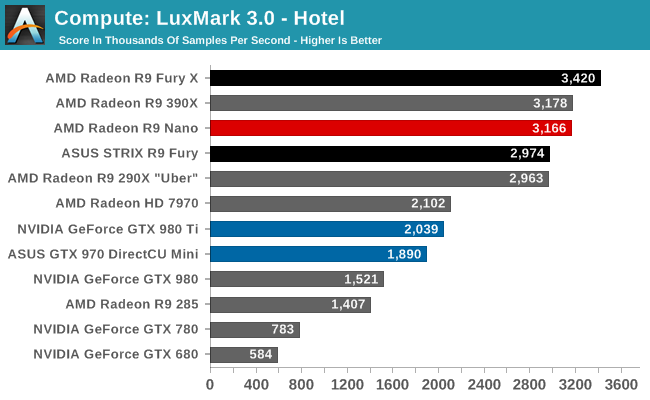
LuxMark ends up being a great corner case for where having a fully enabled Fiji GPU is more important than having the highest clockspeeds. With the R9 Nano able to flirt with its full 1000MHz clockspeed here, the card is able to pass the R9 Fury here. The only thing stopping it from taking the second-place spot is the R9 390X, as Hawaii still sees strong performance here even with fewer SPs.
For our second set of compute benchmarks we have CompuBench 1.5, the successor to CLBenchmark. CompuBench offers a wide array of different practical compute workloads, and we’ve decided to focus on face detection, optical flow modeling, and particle simulations.
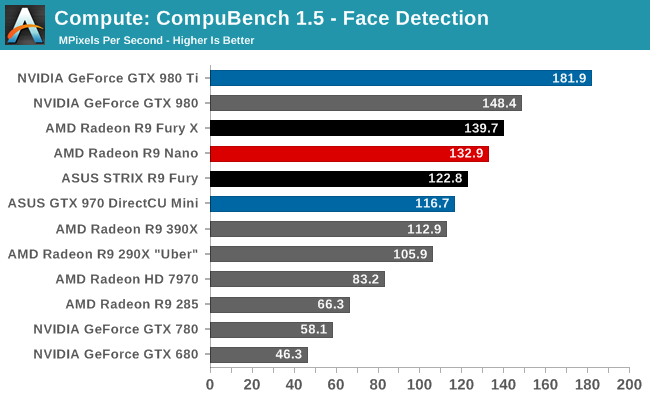
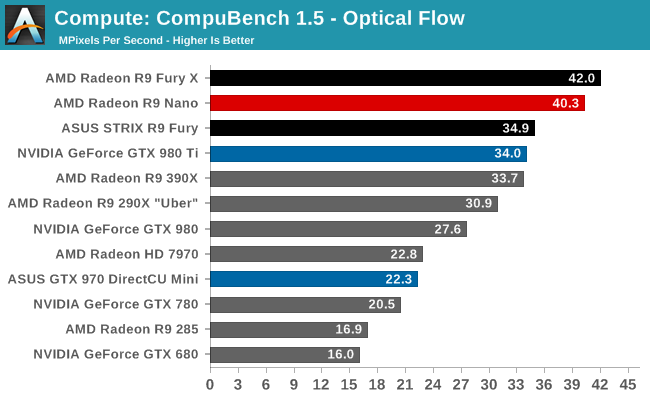
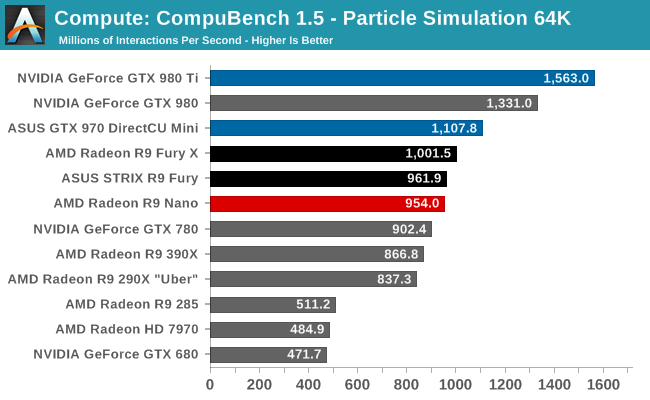
CompuBench provides us another case of where the R9 Nano ends up outpacing the R9 Fury. As a result AMD’s latest card tends to perform somewhere between an R9 Fury and R9 Fury X, with all of the strengths and weaknesses that come from that. This puts the R9 Nano in a good place for Optical Flow, while it will still trail NVIDIA”s best cards under Face Detection and the 64K particle simulation.
Meanwhile it’s interesting to note that AMD’s particle sim scores have significantly improved in the recent drivers. GCN 1.2 cards have seen 20%+ performance improvements here, which may point to some new OpenCL compiler optimizations from AMD.
Our 3rd compute benchmark is Sony Vegas Pro 13, an OpenGL and OpenCL video editing and authoring package. Vegas can use GPUs in a few different ways, the primary uses being to accelerate the video effects and compositing process itself, and in the video encoding step. With video encoding being increasingly offloaded to dedicated DSPs these days we’re focusing on the editing and compositing process, rendering to a low CPU overhead format (XDCAM EX). This specific test comes from Sony, and measures how long it takes to render a video.
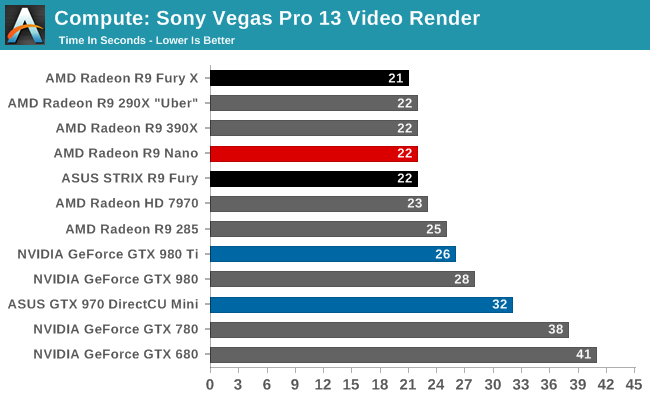
With Vegas there are no surprises; the R9 Nano ties the R9 Fury.
Moving on, our 4th compute benchmark is FAHBench, the official Folding @ Home benchmark. Folding @ Home is the popular Stanford-backed research and distributed computing initiative that has work distributed to millions of volunteer computers over the internet, each of which is responsible for a tiny slice of a protein folding simulation. FAHBench can test both single precision and double precision floating point performance, with single precision being the most useful metric for most consumer cards due to their low double precision performance. Each precision has two modes, explicit and implicit, the difference being whether water atoms are included in the simulation, which adds quite a bit of work and overhead. This is another OpenCL test, utilizing the OpenCL path for FAHCore 17.

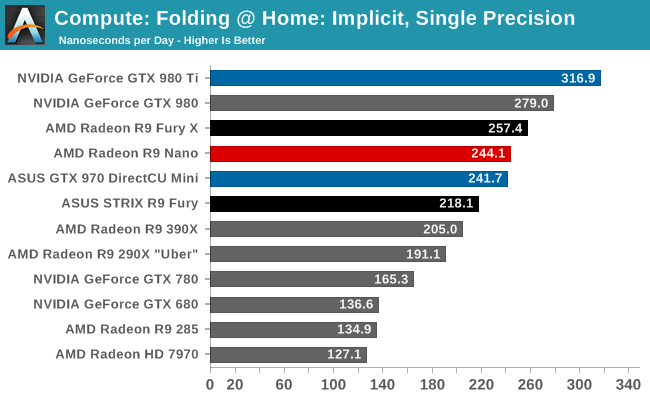
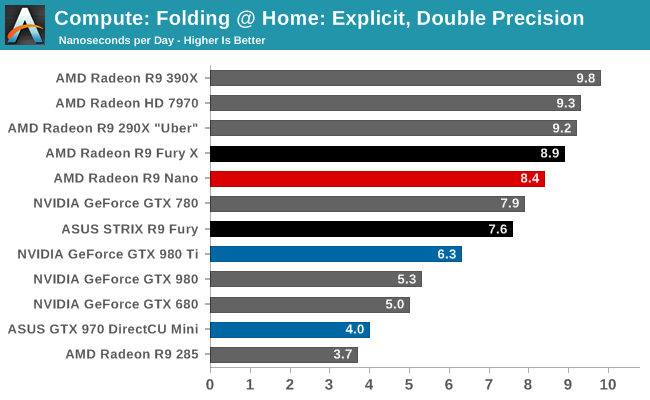
Much like CompuBench and LuxMark, the R9 Nano punches above its weight here. The lack of a graphics workload – and resulting demands on graphics hardware like the ROPs – means most of the card’s power can be allocated to the shaders, allowing higher clockspeeds. This gives the Nano a boost in this situation to bring it much closer to the Fury X, though as far as Folding goes AMD will still trail NVIDIA’s best cards.
Wrapping things up, our final compute benchmark is an in-house project developed by our very own Dr. Ian Cutress. SystemCompute is our first C++ AMP benchmark, utilizing Microsoft’s simple C++ extensions to allow the easy use of GPU computing in C++ programs. SystemCompute in turn is a collection of benchmarks for several different fundamental compute algorithms, with the final score represented in points. DirectCompute is the compute backend for C++ AMP on Windows, so this forms our other DirectCompute test.

Our final test sees the R9 Nano brought back to its place behind the R9 Fury, as the C++ AMP sub-tests are strenuous enough to cause more significant clockspeed throttling. Even behind the R9 Fury the R9 Nano does well for itself here, coming in behind the GTX 980 Ti and head of the R9 390X and GTX 980.










284 Comments
View All Comments
anubis44 - Thursday, October 8, 2015 - link
"you forgot to include evidence of them lying, or a reason for why they would lie."Are you for real? Evidence of misrepresentation is that the box says '4GB', and you can only practically use 3.5GB of the 4GB in a game, or the performance will tank. How much more evidence do you require?
As for a reason why they would do this? You've got to be joking. $$! That's why. The memory controller they used to make a '4GB' card was cheaper than one that would have run all the memory at full speed. That would likely have pushed the price of the card well above $400, and outside of the targeted dupe market of $350-$400. The cheaper, gimped memory controller also meant that nVidia made more profit per card. They just hoped nobody would catch their use of a gimped memory controller before they'd ripped off tens of thousands of slavishly loyal nVidiots who all mindlessly rushed out to computer stores to plunk down their money. And it worked. Tens of thousands have plunked down their money, and nVidia has posted better than ever earnings. What a surprise.
anubis44 - Thursday, October 8, 2015 - link
HA HA HA! An 'honest' mistake? Give me a break! Are you saying nVidia just didn't realize that the cheap memory controller they saddled the GTX970 had a flaw? Yeah, right. They just didn't know that the last .5GB of memory would be gimped by running it at 1/7 the speed of the other 3.5GB. And of course, the decision to use that cheaper memory controller didn't have ANYTHING to do with padding their already fat profit margins at the expense of their customers. Meanwhile, they have the audacity to print '4GB Ram' on all the boxes. As if nVidia just didn't realize that tens of thousands of nVidiots wouldn't go out and buy the cards for a few months before an independent reviewer finally caught them in the act. nVidia is as guilty as a cat in a goldfish bowl, and if you're going to pretend that this whole fiasco was 'handled admirably' by nVidia, then you must really be a fan of Jen Hsun. Seriously, at least have the self-respect to call a spade a spade and admit that nVidia tried to pull a fast one just to line their pockets and got caught.SolMiester - Thursday, September 10, 2015 - link
Oh please, its already been stated that you have to load up beyond normal use before the .5Gb ram comes into play and for the majority or users at 1080, its doesnt effect them.RussianSensation - Thursday, September 10, 2015 - link
@SolMeiser, 1080P is fine but some gamers who purchased GTX970 did so for their 2560x1440/1600 monitors, in addition to others who bought GTX970 SLI. Also, even if in the majority of games the 3.5GB RAM isn't an issue, it's how NV responded to the situation is what's telling.Kutark - Thursday, September 10, 2015 - link
So, what do you have to say about all the dubious shit AMD said during the pre fiji release? They claimed several times it was the fastest card in the world, when it wasn't, and they KNEW it wasn't.I'm tired of people being inconsistent, if you're going to point out questionable behavior in one company then you have to do it for the other.
silverblue - Friday, September 11, 2015 - link
They could've run benchmarks well before the launch, and then fallen behind once NVIDIA had brought out new drivers, or they could've straight out lied. What I'd like to see is AMD's 4K Gaming Performance Benchmarks bar chart scrutinised for every game to see how far out of reality the results were with the setups that were used, then we can be 100% sure (after all, Fiji is more competitive at 4K than lower resolutions).fuicharles - Friday, September 11, 2015 - link
Not giving a review copies to certain reviewer is worse or the one who create gameworks is worse ?Horza - Thursday, September 10, 2015 - link
Thank you for being the impartial voice of reason Wreckage. I've always enjoyed your measured and balanced approach to assessing the merits of the two big dGPU players. Your attack on Anandtech's credibility holds so much more weight coming from a person with a track record of non-partisan, unbiased viewpoints such as yourself. Thank you again.ingwe - Thursday, September 10, 2015 - link
If you read the final words, I think this is a very fair review. To me it says: "This is better than usual form AMD, but it isn't enough and it is too expensive." Seems accurate and unbiased.bill.rookard - Thursday, September 10, 2015 - link
Actually, I do find it 'enough', it -is- a very good, supremely capable card that comes in at 2/3 of the size with 90% of the performance. Heck, it's faster than the GTX 980. My problem? It is too expensive. I know that prime Fiji chips are in short supply at the moment, but it needs to be about $200 cheaper.If they can get their supply running smoothly and get their yields of the full-fat Fiji up, drop the price to about GTX 980 levels they'd never be able to keep them in stock.